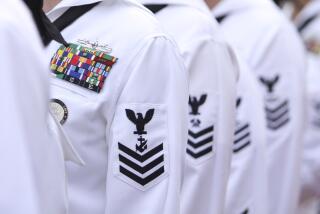Sailor’s death during Navy SEAL training ruled homicide; coroner cites instructors
The death of a 21-year-old sailor during Navy SEAL training has been ruled a homicide by the San Diego County medical examiner.
The autopsy report on James Derek Lovelace says that while some might view the May 6 death as an accident, the “actions, or inactions, of the instructors and other individuals involved were excessive and directly contributed to the death.”
An unnamed Navy instructor in Coronado repeatedly dunked Lovelace under water during a five-minute period, despite instructors pointing the SEAL candidate out as struggling during the “combat” pool exercise, according to the county’s report released Wednesday.
Lovelace had been treated for asthma and had an abnormal enlargement of the heart. The report said the heart abnormality may have been a contributing factor in his death.
The Navy is still investigating and hasn’t determined if charges will be filed, according to a spokesman for the Navy’s criminal policing arm.
“It is important to understand that ‘homicide’ refers to ‘death at the hands of another’ and a homicide is not inherently a crime,” a Navy statement released Wednesday said. “The autopsy report does not signal that the Naval Criminal Investigative Service investigation into Seaman Lovelace’s death has culminated, nor that conclusions have been reached regarding criminal culpability.”
It is believed to be the first time a Navy SEAL candidate’s death has been ruled a homicide, according to people familiar with the Naval Special Welfare community. If anyone is charged in the incident, it also likely probably would be a first.
An instructor involved in Lovelace’s training, who has not been named, was removed from his position and placed on administrative duties, the Navy has said.
SEAL instructors are not supposed to dunk or pull students underwater, according to the county report. A spokesman for the Navy SEAL training center in Coronado said he could not discuss the issue because the investigation was continuing.
Another student in the pool tried to help Lovelace keep his head above water, according to the medical examiner’s narrative, which described the scene based on video of the event:
“An instructor observing from the dive platform is seen to point out the decedent [Lovelace], who appeared to be struggling, and an instructor in the water approaches the decedent. That instructor is seen to dunk the decedent under the water and then follow him around the pool for approximately 5 minutes. He continually splashes the decedent, dunks him at least one additional time, and appears to be yelling at him. The decedent is also splashed by other individuals during the event.
“At one point in the video, another individual in the water is seen pulling him up and away from the instructor. Throughout this time period, the decedent’s head is seen to go under the water multiple times, and the instructor can be seen pulling him up multiple times. Eventually the instructor pulls him out of the water, and the exercise is stopped.”
Lovelace, who was from Crestview, Fla., was in his first week of the notoriously difficult six-month course to become a SEAL. Only about 25% of candidates make it through without dropping out.
The candidate course includes workouts in the pounding surf, running with logs and rubber boats overhead, swims and a no-sleep “Hell Week” meant to weed out all but the most determined sailors.
The pool training is called “combat swimmer orientation” and involves SEAL candidates swimming and treading water while wearing fatigues, boots and masks. Retired SEAL officer Bob Schoultz said the point was to see how candidates respond in the water under stress.
There were signs during the exercise that Lovelace, known to be a weak swimmer, was in distress.
Witnesses reported that his face was purple and his lips were blue, according to the county’s report. When pulled from the pool still breathing, he was mumbling and could track with his eyes. Abundant “discolored water” came out of his mouth when he was turned on his side.
But when the SEAL candidate was turned on his back again, he became unresponsive. Resuscitation didn’t work and he was declared dead at Sharp-Coronado hospital later that day.
The Navy SEAL command has added training on symptoms of water injuries since the incident.
Lovelace is at least the fifth SEAL candidate to die while going through the training in the last three decades, according to San Diego Union-Tribune research.
In March 1988, John Joseph Tomlinson, 22, from Altoona, Pa., died of hypothermia near the end of a 5½-mile ocean swim off Coronado in the 17th week of the 25-week course.
In July 1998, Gordon Racine Jr., 25, of Houston died during a pool exercise in his first month of training.
In March 2001, Lt. John Anthony Skop Jr., 29, of Buffalo, N.Y., died during a Hell Week swimming exercise.
In February 2004, Boatswain Mate 1st Class Rob Vetter, 30, died at a Coronado hospital days after he collapsed while participating in a conditioning run in the second week of the program for SEAL candidates.
Schoultz said SEAL officials have made significant efforts to make training safer, including checking the core temperatures of sailors during stretches when hypothermia could be an issue. Compared with prior decades that were more “wild west,” he said, “they have really professionalized the training.”
Read the coroner’s report here.
Steele writes for the San Diego Union-Tribune.
ALSO
4-year-old boy killed, man injured in drive-by shooting in Altadena
No Mega Millions winner means lottery jackpot soars to $508 million
In Vietnam, news of a comedian’s arrest in O.C. on molestation charges is being closely watched
UPDATES:
6:26 p.m.: This post was updated with additional information.
11:09 a.m.: This post was updated with more details.
This post was originally published at 8:21 p.m.
More to Read
Start your day right
Sign up for Essential California for news, features and recommendations from the L.A. Times and beyond in your inbox six days a week.
You may occasionally receive promotional content from the Los Angeles Times.






